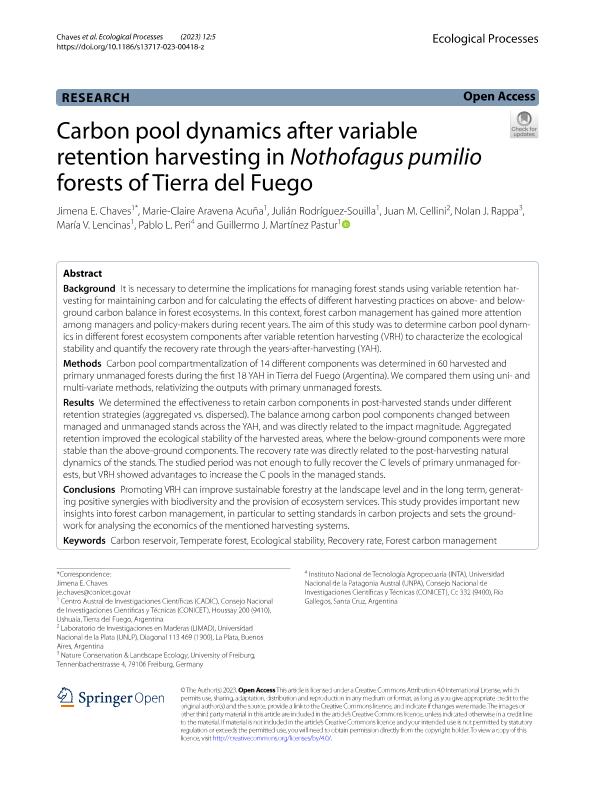Artículo
Carbon pool dynamics after variable retention harvesting in Nothofagus pumilio forests of Tierra del Fuego
Chaves, Jimena Elizabeth ; Aravena Acuña, Marie Claire Alejandra
; Aravena Acuña, Marie Claire Alejandra ; Rodriguez Souilla, Julian
; Rodriguez Souilla, Julian ; Cellini, Juan Manuel; Rappa, Nolan J.; Lencinas, María Vanessa
; Cellini, Juan Manuel; Rappa, Nolan J.; Lencinas, María Vanessa ; Peri, Pablo Luis
; Peri, Pablo Luis ; Martínez Pastur, Guillermo José
; Martínez Pastur, Guillermo José
 ; Aravena Acuña, Marie Claire Alejandra
; Aravena Acuña, Marie Claire Alejandra ; Rodriguez Souilla, Julian
; Rodriguez Souilla, Julian ; Cellini, Juan Manuel; Rappa, Nolan J.; Lencinas, María Vanessa
; Cellini, Juan Manuel; Rappa, Nolan J.; Lencinas, María Vanessa ; Peri, Pablo Luis
; Peri, Pablo Luis ; Martínez Pastur, Guillermo José
; Martínez Pastur, Guillermo José
Fecha de publicación:
12/2023
Editorial:
Springer
Revista:
Ecological Processes
e-ISSN:
2192-1709
Idioma:
Inglés
Tipo de recurso:
Artículo publicado
Clasificación temática:
Resumen
Background: It is necessary to determine the implications for managing forest stands using variable retention harvesting for maintaining carbon and for calculating the effects of different harvesting practices on above- and below-ground carbon balance in forest ecosystems. In this context, forest carbon management has gained more attention among managers and policy-makers during recent years. The aim of this study was to determine carbon pool dynamics in different forest ecosystem components after variable retention harvesting (VRH) to characterize the ecological stability and quantify the recovery rate through the years-after-harvesting (YAH). Methods: Carbon pool compartmentalization of 14 different components was determined in 60 harvested and primary unmanaged forests during the first 18 YAH in Tierra del Fuego (Argentina). We compared them using uni- and multi-variate methods, relativizing the outputs with primary unmanaged forests. Results: We determined the effectiveness to retain carbon components in post-harvested stands under different retention strategies (aggregated vs. dispersed). The balance among carbon pool components changed between managed and unmanaged stands across the YAH, and was directly related to the impact magnitude. Aggregated retention improved the ecological stability of the harvested areas, where the below-ground components were more stable than the above-ground components. The recovery rate was directly related to the post-harvesting natural dynamics of the stands. The studied period was not enough to fully recover the C levels of primary unmanaged forests, but VRH showed advantages to increase the C pools in the managed stands. Conclusions: Promoting VRH can improve sustainable forestry at the landscape level and in the long term, generating positive synergies with biodiversity and the provision of ecosystem services. This study provides important new insights into forest carbon management, in particular to setting standards in carbon projects and sets the groundwork for analysing the economics of the mentioned harvesting systems.
Archivos asociados
Licencia
Identificadores
Colecciones
Articulos(CADIC)
Articulos de CENTRO AUSTRAL DE INVESTIGACIONES CIENTIFICAS
Articulos de CENTRO AUSTRAL DE INVESTIGACIONES CIENTIFICAS
Articulos(SEDE CENTRAL)
Articulos de SEDE CENTRAL
Articulos de SEDE CENTRAL
Citación
Chaves, Jimena Elizabeth; Aravena Acuña, Marie Claire Alejandra; Rodriguez Souilla, Julian; Cellini, Juan Manuel; Rappa, Nolan J.; et al.; Carbon pool dynamics after variable retention harvesting in Nothofagus pumilio forests of Tierra del Fuego; Springer; Ecological Processes; 12; 1; 12-2023; 1-19
Compartir
Altmétricas



